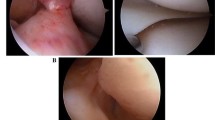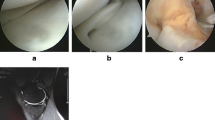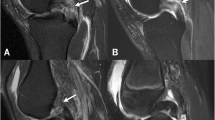Abstract
Magnetic resonance imaging (MRI) is the most widely used non-invasive test for assessing intra-articular injuries of the knee. It has been suggested that a negative MRI can be useful in avoiding the need for diagnostic arthroscopy in cases where clinical examination is equivocal. However, the sensitivity and specificity of MRI is not 100%, particularly for tears of the lateral meniscus. Furthermore, a false negative MRI scan may result in premature return to play in athletes, resulting in increased risk of further damage to a torn meniscus. To illustrate this issue, we present a case series of eight elite athletes who all presented with mechanical knee symptoms and where MRI scans revealed no significant intra-articular pathology. Five of the athletes were allowed to return to sport on the basis of a negative MRI. All patients were subsequently found to have a bucket-handle tear of their lateral meniscus at arthroscopy. Two independent, experienced musculoskeletal radiologists were asked to review the MRI films without being given any clinical history of the cases. Although injuries to the popliteus tendon were noted in two of the athletes who had sustained a recent acute injury to their knee, no meniscal tears were identified. Thus arthroscopy remains the gold standard for the assessment and management of high-demand patients with a clinical suspicion of meniscal pathology.
Similar content being viewed by others
References
Sherman OH et al (1986) Arthroscopy—“no-problem surgery”. An analysis of complications in two thousand six hundred and forty cases. J Bone Joint Surg Am 68(2):256–265
McNally EG et al ( 2002) Role of magnetic resonance imaging in the clinical management of the acutely locked knee. Skeletal Radiol 31(10):570–573
Feller JA, Webster KE (2001) Clinical value of magnetic resonance imaging of the knee. ANZ J Surg 71(9):534–537
Elvenes J et al (2000) Magnetic resonance imaging as a screening procedure to avoid arthroscopy for meniscal tears. Arch Orthop Trauma Surg 120(1–2):14–16
Weinstabl R et al (1997) Economic considerations for the diagnosis and therapy of meniscal lesions: can magnetic resonance imaging help reduce the expense? World J Surg 21(4):363–368
Fritz RC (2003) MR imaging of meniscal and cruciate ligament injuries. Magn Reson Imaging Clin N Am 11(2):283–293
Rappeport ED et al (1997) MRI preferable to diagnostic arthroscopy in knee joint injuries. A double-blind comparison of 47 patients. Acta Orthop Scand 68(3):277–281
Rappeport ED et al (1996) MR imaging before arthroscopy in knee joint disorders? Acta Radiol 37(5):602–609
Alioto RJ et al (1999) The influence of MRI on treatment decisions regarding knee injuries. Am J Knee Surg 12(2):91–97
Boden SD et al (1992) A prospective and blinded investigation of magnetic resonance imaging of the knee. Abnormal findings in asymptomatic subjects. Clin Orthop Relat Res Sep(282):177–185
Solomon DH et al (2001) The rational clinical examination. Does this patient have a torn meniscus or ligament of the knee? Value of the physical examination. JAMA 286(13):1610–1620
Shiozaki Y et al (2002) Prediction of reparability of isolated semilunar lateral meniscus tears by magnetic resonance imaging. Knee Surg Sports Traumatol Arthrosc 10(4):213–217
Elkousy H, Sekiya J, Harner C, (2002) Broadening the indications for meniscal repairs. Sports Med Arthrosc Rev 10(4):270–276
De Smet AA et al (1993) MR diagnosis of meniscal tears of the knee: importance of high signal in the meniscus that extends to the surface. AJR Am J Roentgenol 161(1):101–107
Sparacia G et al (2002) Pitfalls and limitations of magnetic resonance imaging in bucket-handle tears of knee menisci. Radiol Med (Torino) 104(3):150–156
De Smet AA, Graf BK (1994) Meniscal tears missed on MR imaging: relationship to meniscal tear patterns and anterior cruciate ligament tears. AJR Am J Roentgenol 162(4):905–911
Blankenbaker DG, De Smet AA, Smith JD (2002) Usefulness of two indirect MR imaging signs to diagnose lateral meniscal tears. AJR Am J Roentgenol 178(3):579–582
Fischer SP et al (1991) Accuracy of diagnoses from magnetic resonance imaging of the knee. A multi-center analysis of one thousand and fourteen patients. J Bone Joint Surg Am 73(1):2–10
Raunest J et al (1991) The clinical value of magnetic resonance imaging in the evaluation of meniscal disorders. J Bone Joint Surg Am 73(1):11–16
Acknowledgements
The authors would like to thank Drs. David Connell and Frank Malara (Victoria House Medical Imaging, Melbourne, Australia) for their assistance in reviewing the MRI films and helpful discussion of the results.
Author information
Authors and Affiliations
Corresponding author
Rights and permissions
About this article
Cite this article
Makdissi, M., Eriksson, K.O., Morris, H.G. et al. MRI-negative bucket-handle tears of the lateral meniscus in athletes: a case series. Knee Surg Sports Traumatol Arthrosc 14, 1012–1016 (2006). https://doi.org/10.1007/s00167-005-0011-8
Received:
Accepted:
Published:
Issue Date:
DOI: https://doi.org/10.1007/s00167-005-0011-8




